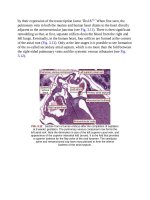Andersons pediatric cardiology 167
Bạn đang xem bản rút gọn của tài liệu. Xem và tải ngay bản đầy đủ của tài liệu tại đây (107.08 KB, 3 trang )
ofnormalfetusesstudiedfrom20to30weeksofgestation,andanincreasein
theproportionofthecardiacoutputfromtherightsideto60%atterm.95
Pulmonaryvascularresistanceincreasesduringthelasttrimester.Thisagain
changesthebalanceofthecardiacoutput,increasingflowintothesystemic
circulation.TheDopplerwaveformofthebranchpulmonaryarteriesis
characterizedbyasharpsystolicupstrokewithashortaccelerationtimeand
reversalofflowinlatesystole(Fig.6.13).Studieshavecorrelatedthesefindings
withpressureandcirculatoryeventsinfetallambsandattributethereversalof
flowtothelowcomplianceofthebranchpulmonaryarteriesandhigh
pulmonaryvascularresistanceinthefetus.93
FIG.6.13 Dopplerwaveforminthebranchpulmonaryarteriesis
characterizedbyasharpsystolicupstroke,ashortaccelerationtimeanda
notch,orreversalofflowinlatesystole.
Optimalperinatalplanningrequiresthepredictionofimportantfetal
pulmonaryhypoplasia,bothtoaidcounselingofparentsandtopreparethe
resourcesrequiredforneonatalresuscitationandsupport.Early
echocardiographicratios,suchastheratioofsizesofthelungsandhead,were
derivedtopredictpulmonaryhypoplasiaincaseswithdiaphragmatichernia.A
ratiolessthan0.6wasassociatedwithpooroutcome,whereasaratiogreater
than1.4predictedsurvival.96Alternativeindexesoftheratiooffetallung
volumetofetalbodyweightusingMRIincombinationwithultrasonography
havebeendevised.97OthershaveusedMRIalonetoassessthetotallung
volumebycomparingthesignalintensityoflungtothatofspinalfluid.98MRI
andultrasoundarecomplimentaryimagingmethodsforpredictingfetal
pulmonaryhypoplasiaandtheprognosticaccuracyofobserved-to-expectedMRI
fetallungvolumeandobserved-to-expectedultrasoundlung-to-headratiohave
beenpublished.99Bothmethodshaveshowncomparableabilitytoassesslung
volumesinleftsideddiaphragmatichernia,particularlybefore32gestational
weeks,althoughtheultrasoundmethodoverestimateslungsizeby1.5to1.8
comparedwithMRImethods.However,neitherwereusefulpredictorsof
outcomeinright-sidedlesions.99Dopplerparameterssuchasthepulsatility
indexhavenotbeenfounddiscriminatoryforpulmonaryhypoplasia100and
promptedinvestigationofphysiologictestingofthefetalpulmonarybed.
Maternalhyperoxiatestingstudieshaveattemptedtodeterminewhetherthe
near-termfetuswithcertaincongenitaldefectssuchasdiaphragmaticherniaor
hypoplasticleftheartsyndromecanrespondtoa15-minuteadministrationof
100%oxygendeliveredtothemotherviafacemaskbyincreasingpulmonary
bloodflow.101,102
Interpretationoftheresultsofacuteadministrationofoxygenaremade
difficultbytechnicalconsiderationssuchasensuringaccuracyofplacementof
theDopplersamplevolumesothatthesamepartofthepulmonarytreeis
sampledbeforeandafteroxygenadministration.Thisimagingisparticularly
challenginginthesettingofdiaphragmatichernia.
Muchuncertaintyexistsaroundtheroleandefficacyofchronicadministration
ofoxygentothepregnantwoman.Long-termmaternaladministrationofoxygen
byfacemaskfor6or8hoursadayoverseveralweeksisthoughttoincrease
pulmonaryvenousreturninresponsivefetuses,andthisinturnmaypromote
growthofleft-sidedheartstructuresinborderlineleftheartsorthosewithaortic
coarctation.Althoughaplausibletheory,outcomeshavebeenlessthan
convincing,andmoreresearchisrequiredtoestablish,forexample,theeffects
ofchronicoxygenadministrationonthefetalretina,andtoprovidearobust
evaluationofitscardiovasculareffectsabovenaturalhistoryoutcomes.Littleis
yetknownofthedeterminantsofresponsivenessinthesecondandthird
trimesterfetus.103–105
CoronaryArterialFlow
Innormalfetuses,flowinthecoronaryarteriesisnotusuallyseenuntilthethird
trimester.Referencerangesforvelocitieshavebeendescribedanddonotappear
tochangewithgestationalageinthestructurallynormalheart.106Visibleflow
wasfirstdescribedinterminallysickfetusesandproposedasanadditional
predictorofadverseoutcome(Video6.11).107
Fetalultrasoundmayalsodemonstratevisiblecoronaryarterialflowin
conditionsassociatedwithrestrictionofgrowth,anemia,constrictionofthe
arterialduct,twin-twintransfusionsyndrome(TTTS),andbradycardia,thus
demonstratingshort-termautoregulationandlong-termalterationsinmyocardial
flowreserveinthehumanfetus.Itcanbedemonstratedingrowth-restricted
fetusesearlieringestationthaninappropriatelygrownfetusesandathigher
velocity.Fetuseswithanemiashowthehighestvelocitiesinthecoronary
arteries,perhapsreflectingincreasedleftventricularoutputduetoareductionin
cerebralimpedanceinresponsetobothpathologicsituations(Fig.6.14).
Coronaryarterialflowisnolongervisibleoncetheunderlyingcausehasbeen
treated,forexamplebyintrauterinefetaltransfusionforanemia,orbystopping
anycausativemedicationsuchasindomethacininthecaseofconstrictionofthe
arterialduct.









